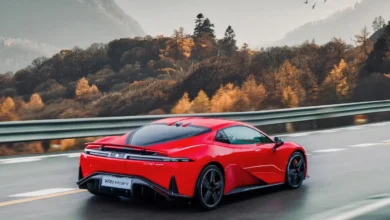XPeng X2: The Autonomous eVTOL Shaping the Future of Urban Air Mobility

The race for next-generation urban air mobility is heating up, and XPeng AeroHT’s X2 stands out as one of the most ambitious fully autonomous eVTOLs (electric Vertical Takeoff and Landing vehicles) in development. Unlike hybrid “flying cars” that also drive on roads, the XPeng X2 is designed purely for flight, offering a glimpse into a future where autonomous air taxis could revolutionize short-distance travel.
Scheduled for limited release in China by 2025 and globally by 2026, the X2 represents a major leap in autonomous aviation technology. With successful test flights in Dubai and cutting-edge self-piloting capabilities, this eVTOL could soon become a key player in urban air mobility (UAM).
1. What Is the XPeng X2?
The XPeng X2 is a two-seater, fully electric, autonomous eVTOL developed by XPeng AeroHT, the aviation division of Chinese EV maker XPeng Motors. Unlike some competitors exploring road-and-air hybrids, the X2 is exclusively an aircraft, focusing on short urban commutes, emergency services, and aerial tourism.
Key Features:
✔ Fully Autonomous – No pilot needed, with AI-controlled flight.
✔ Zero Road Functionality – Designed purely for flight, not driving.
✔ Lightweight Carbon Fiber Construction – Enhances efficiency and safety.
✔ Low Noise Levels – Quieter than helicopters, ideal for cities.
✔ Expected Rollout – China (2025), Global (2026).
2. Design & Engineering: How Does It Work?
A. Flight Capabilities & Performance
-
Vertical Takeoff & Landing (VTOL) – No runway needed, takes off like a drone.
-
Range: 22 miles (35 km) per charge (based on test flights).
-
Max Speed: 80 mph (130 km/h).
-
Flight Altitude: Up to 1,000 meters (3,280 ft).
-
Battery Tech: High-density electric batteries with fast-charging capability.
B. Autonomous Flight System
The X2’s most groundbreaking feature is its autonomous flight capability, powered by:
-
AI-driven navigation (real-time obstacle avoidance).
-
Redundant flight control systems for safety.
-
Pre-programmed routes for urban air mobility networks.
C. Safety & Redundancy
-
Multiple rotor systems (fail-safe redundancy).
-
Emergency parachute deployment.
-
Remote monitoring by ground control centers.
3. Where Has It Been Tested?
The X2 has already completed multiple successful test flights, including:
✅ Dubai (2022-2023) – Demonstrated urban flight potential in a smart city environment.
✅ China (Ongoing) – Preparing for 2025 commercial trials.
These tests prove its viability for short-hop urban flights, such as airport transfers or city-center commutes.
4. Potential Use Cases
A. Urban Air Taxis
-
Short-distance commutes (e.g., business districts to airports).
-
Reduces traffic congestion in megacities like Dubai, Shanghai, and Singapore.
B. Emergency & Medical Transport
-
Faster than ambulances in gridlocked cities.
-
Delivering medical supplies to remote areas.
C. Tourism & VIP Transport
-
Aerial sightseeing without needing a pilot.
-
Luxury private transit for high-net-worth individuals.
5. Challenges & Limitations
While the X2 is an impressive feat of engineering, it faces hurdles:
A. Regulatory Approval
-
Civil aviation authorities must certify autonomous passenger flights.
-
Air traffic control systems need upgrades for drone-like eVTOLs.
B. Battery & Range Constraints
-
22-mile range limits initial use to short urban hops.
-
Charging infrastructure must expand for fleet operations.
C. Public Trust in Autonomy
-
Will passengers feel safe without a pilot?
-
Early adoption may be limited to commercial/logistics use.
6. XPeng X2 vs. Competitors
| Feature | XPeng X2 | ASKA A5 | Joby Aviation S4 |
|---|---|---|---|
| Autonomy | Fully Autonomous | Pilot-Required | Pilot-Optional |
| Road Use? | No | Yes | No |
| Range | 22 miles | 250 miles | 150 miles |
| Release | 2025 (China), 2026 (Global) | 2026 | 2025 (Commercial) |
The X2’s full autonomy sets it apart, but its limited range means it won’t replace traditional aircraft anytime soon.
7. What’s Next? (2025-2026 Roadmap)
-
2024-2025: Expanded test flights in China & Middle East.
-
2025: Limited commercial rollout in Chinese smart cities.
-
2026: Global expansion, pending regulatory approvals.
XPeng AeroHT is also developing a next-gen eVTOL (X3?) with longer range and higher capacity, hinting at an evolving product line.
Conclusion: Is the XPeng X2 the Future of Urban Flight?
The XPeng X2 is a bold step toward autonomous urban air mobility, offering a pilotless, eco-friendly alternative to helicopters and ground transport. While its current range is limited, it could become a key player in short-distance air taxis by the late 2020s.
The big question: Will passengers embrace autonomous flight? If XPeng succeeds, the X2 could help usher in a new era of sky-bound commuting.





